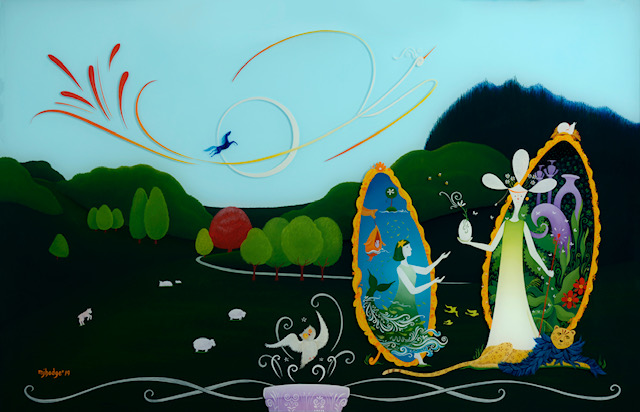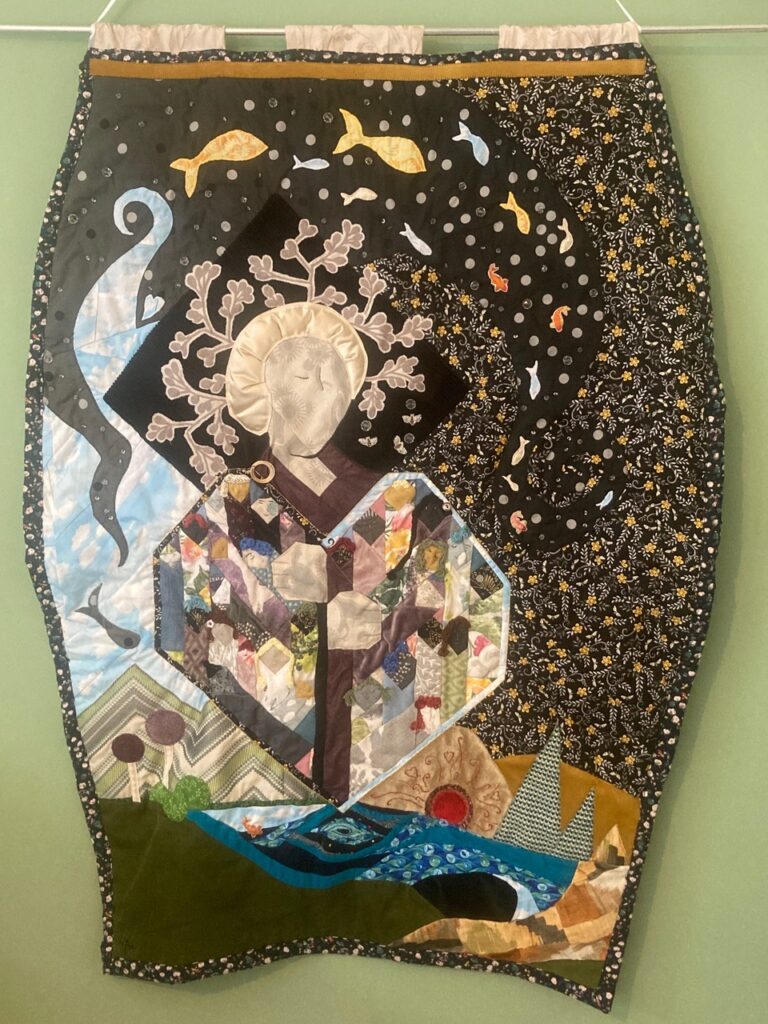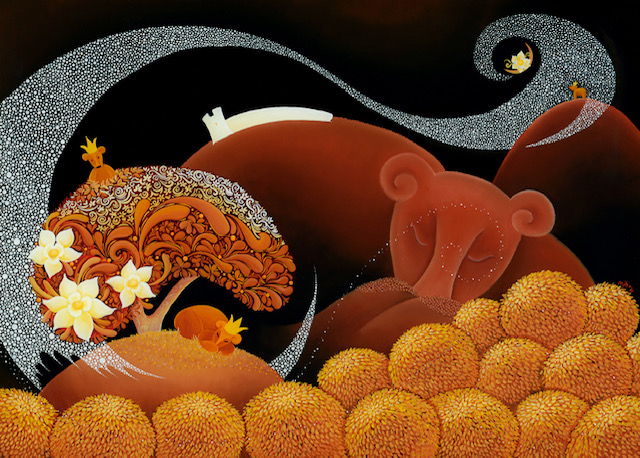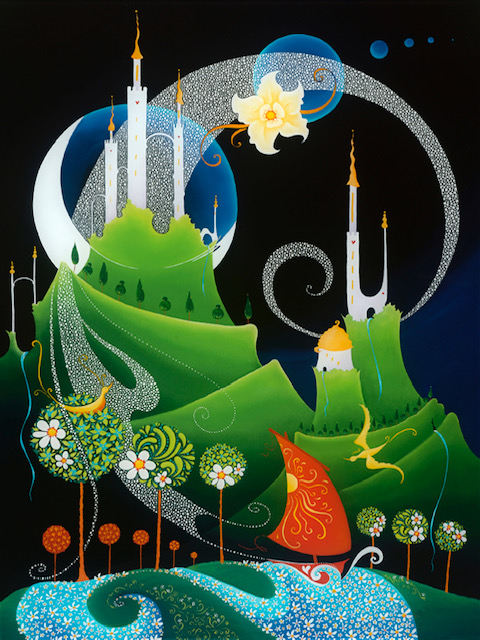
JANE BURN – POETRY AS HARD GRAFT, INSPIRATION, REACTION OR EXPERIMENT?
I interviewed poet & artist Jane Burn who won the Michael Marks Environmental Poet of the Year 2023-24 with A Thousand Miles from the Sea.

I interviewed reverse-glass painter and quilt maker Melanie Hodge abut her art/life balance as a parent-carer and how she has integrated her love for her children into her complex creative work and health needs.
Leslie: Your art has two major strands: reverse-painting in oils on glass and sewing quilts. What are the characteristics of these two methods and how do they fit to your mental & physical health and practical life needs?
Melanie: I have been making quilts on and off for nearly 40 years if you count my very first doll quilt. I’ve been painting for even longer, but I’ve only been reverse-glass painting in the last 10 years – and that too in an on-off manner.
Until recently I would have said glass painting is my truest creative-expression – the slow and backwards process opening a metaphorical door into a visual vocabulary which feels most truly ‘me.’ The quilt making was, in contrast, quick-making gratification in practice.
I say ‘until recently’ because in the last few months my quilting has taken a turn towards figurative tapestry-like work as I’ve had to more fully adapt to a less intensive, less visually challenging medium.
In large part this has been the result of ongoing on/off ill health in parallel with pandemic home-schooling. This was followed by several months of persistent vertigo with visually triggered symptoms (now diagnosed as Meniere’s disease). All of this has made working on a highly reflective and refractive surface particularly difficult.

At the same time, this feels like the inevitable marrying of two long-standing sensory needs. Glass painting delights my eyes with spiralling details (which pre-patterned fabric allows more easily) and quilting allows me to experience the world, and my making, through touch and texture – a need heightened (in a way only deprivation can drive) by the ‘no touch/ no hugs’ imperative of the 2020’s pandemic.
I would also add a 3rd strand to my practice. That is my role as a parent-carer for my two children, one of whom has lifelong social-communication and learning difficulties related to his Autism.
By braiding these strands together into one very non-traditional art practice I’ve discovered that there is a balance to be found: between the amount of focus I can sustain and a level of productivity that keeps me feeling well.
Changing my perspective so that caring became an integral part of my practice, revolutionized how I felt about my work and reduced the amount of stress I experienced. Feeling that the children took me away from my art wasn’t good for my mental health. Now that has changed, I have the same push-me-pull-you relationship with my own health as I have with them.
Incorporating my daily life, including my physical limitations and caring responsibilities, into my practice makes me feel much more of a full-time artist, giving me an identity beyond my caring, while also allowing me to adapt my making to the amount of energy I have.
Leslie: How did your early life prepare you for the role of artist? What have been the key developments since then that have guided your art?
Melanie: As a child growing up in the US ‘art’ was doodling in the edges of my notebook, the odd drawing or painting class, and classroom crafts that were busy-work as much as anything else. I was primarily a reader and a writer, but a maker only around the edges. For example, at university I didn’t take an art degree yet still squeezed an art class into my schedule because, though I couldn’t articulate it, I needed it. Today I’d say I needed it ‘for my mental health’, but then, I just knew it made me happier. But even when one art professor encouraged me to change my course, I couldn’t make the jump. His words, ‘you will always be able to come back to art’ stuck with me though and it was art that accompanied my travels, played a part in meeting my British husband, provided purpose in the peripatetic life of a diplomat’s wife, and gave me confidence in my own parenting instincts when the children were younger and autism a relatively unknown condition. And today – it still makes me happier if I’m making on the edges of whatever else I might be dealing with.

In hindsight, I find it mind-boggling that it still took nearly four decades before I could call myself an artist. If there’s anything I can pass onto other creatives I’d like it to be the confidence to identify your creativity and name yourself as early as you can. The Romantic mythology of ‘The Artist’ has failed us and everyone should feel free to call themselves an artist at every stage of their development, regardless of their media, and no matter how minimal their ‘practice’ or non-existent their sales.
Leslie: Can you tell us about the subjective and objective demands of reverse-painting in oils on glass? What are the difficulties and the rewards?
Melanie: Reverse painting on glass is slow – oil paint takes a long time to dry on canvas and even longer on non-porous glass. I also need to let each layer of detail dry before I add the next. I use a cocktail stick / toothpick to add stars and a 000 brush to paint the vast majority of all elements. This requires deep concentration – akin to meditating when it’s all going well – and is also slow. But many art mediums are slow, and I am good at the long game.
Practically, I start with a plain piece of glass and a rough sketch. The sketch outlines major features of the work. Often with elements added or shifted along the way, sometimes evolving only as I put paint to glass. My sketches are filled with notes to help me remember ideas as the work develops over the weeks, months and sometimes years it takes before I get to painting that particular element. For images which I draw and also want to read from left to right (think known landmarks / -scapes), I often transfer my paper sketch onto a sheet of plastic, which I can flip in order to ‘reverse’ the image before I place it under the glass.

When painting, I start by signing my name – backwards. Fine details go in next with the very last background layer also being the very last layer of paint. That’s because the detail must go on first, and as the finished work is displayed through the glass, my signature has to be in mirror writing when I do it, or it’ll read backwards from the front.
It is very much an ‘Alice through the looking glass’ medium and perhaps for this very reason, it has opened windows into my subconscious, bringing out the playful, the surreal, and the fantastic.
As for the rewards – I love the sensory feedback of working with oils on glass: the smell of linseed oil, the gloss of vibrant colour, the sweeping away of paint to reveal a fine, curving line. I enjoy the slow building of detail and the fact that aside from a few peeks along the way to ensure my background colours aren’t losing earlier details, I love that I don’t actually know how a painting will work overall until its final layer is on and had time to dry. Only then can I turn it around for the full effect. It’s like pulling a rabbit from a hat every time – pure magic because, honestly, I do an awful lot of overthinking and it’s nice to take myself by surprise.
As a side note – seeing the visual imagery of my glass paintings emerge in my most current fabric-born work-in-progress has also been filled with magic. Pulling scraps from over a dozen upcycled quilt stashes and remnants, editing them, arranging them, utilizing texture as well as pattern – it’s not the same as painting on glass, but it is a deeply satisfying process. And as a result, my changing media has come to feel like an opportunity rather than a punishment.
I do need to be clear about this though … my vertigo, while improving, continues to have a severe and significantly limiting impact on my ability to read and write. That definitely does not feel like an opportunity and remains, euphemistically and literally, a different kind of work-in-progress.

Leslie: You’re a member of the Association of British Naïve Artists and the outsider art charity Outside In. What is it about the themes, techniques and inspirations for your work that fits the label Naïve Art / Outsider Artist?
Melanie: I describe myself as a naive artist because I work in a naive manner, both literally and visually. I am mostly self-taught in both my main mediums and my work is done on a single plane, without perspective or much effort at realism. I also come at my subjects from a place of wonder and affection which I hope makes my work approachable and relatable, much like a good fairy story – or as one artist reviewer described it ‘magic folk art.’
I also describe myself as an outsider artist in that I work in unconventional ways in unconventional mediums and because my practice is inseparable from my physical and mental caring and health. These factors also mean that I cannot participate in most mainstream / conventional artist opportunities nor market myself easily in any one niche market. Any one of these things alone could be isolating, and all together could overwhelm anyone. But in identifying myself as an outsider artist, and especially belonging to and being an Ambassador for the art charity Outside In, gives me an enormous sense of community and a platform from which I can be my true self across all the strands of my practice.
Leslie: What is Creative Carers and why did you found it?
Melanie: I founded Creative Carers almost by accident when a parent-carer I knew through my son’s specialist school asked if I taught any art classes. I replied, “I do now.” And it was fabulous – I had a group of 4 parent-carers come to my house and we painted, sketched, and played with glitter. Over time the group moved in different directions so I moved to offering one-off workshops and now offer a free mentoring & information researching service for carers wanting to develop or return to creative activities but unsure where to begin.
For those looking to learn how to paint on glass I also run on-demand in-person and online workshops via Art Experiences.
I am not good at marketing myself due to all the other balls I juggle at the moment, but should anyone be interested in joining my mailing list or getting in touch please visit my websites & social media (details below).
Leslie: There’s a multi-disciplinary strand to your creativity (particularly learning languages and understanding neurodiversity). What is it about you that has made you such a mental (and, in the past, physical) traveller/adventurer?
Melanie: I am not really sure. A friend who did an astrology reading for me years ago, asked me how I managed so many creative interests, so maybe it’s in my stars? Or an inborn resistance to following the herd that comes from my own neuro-experience? What I do know is that I am curious about other people, actively look for wonder, and like working with my hands and head and heart all together. I also like figuring things out for myself and, when making, prefer the shifting sands of working just out of my depth to repetition. All of these factors play a part in making me who I am and giving me an art practice that continues to challenge and fulfill me in equal measure.
Next week I interview new music virtuoso saxophonist Andrew J. Hosler who won first prize in the 2022 Vivaldi International Music Competition.
ABOUT LESLIE TATE’S BOOKS:

I interviewed poet & artist Jane Burn who won the Michael Marks Environmental Poet of the Year 2023-24 with A Thousand Miles from the Sea.

I interviewed ex-broadcaster and poet Polly Oliver about oral and visual poetry, her compositional methods, and learning the Welsh language. Polly says, “I absolutely love

I interviewed Jo Howell who says about herself: “I’ve been a professional photographic artist since I left Uni in 2009. I am a cyanotype specialist.


Poet Tracey Rhys, writer of Teaching a Bird to Sing and winner of the Poetry Archive’s video competition reviews Ways To Be Equally Human. Tracey,
| Cookie | Duration | Description |
|---|---|---|
| cookielawinfo-checkbox-analytics | 11 months | This cookie is set by GDPR Cookie Consent plugin. The cookie is used to store the user consent for the cookies in the category "Analytics". |
| cookielawinfo-checkbox-functional | 11 months | The cookie is set by GDPR cookie consent to record the user consent for the cookies in the category "Functional". |
| cookielawinfo-checkbox-necessary | 11 months | This cookie is set by GDPR Cookie Consent plugin. The cookies is used to store the user consent for the cookies in the category "Necessary". |
| cookielawinfo-checkbox-others | 11 months | This cookie is set by GDPR Cookie Consent plugin. The cookie is used to store the user consent for the cookies in the category "Other. |
| cookielawinfo-checkbox-performance | 11 months | This cookie is set by GDPR Cookie Consent plugin. The cookie is used to store the user consent for the cookies in the category "Performance". |
| viewed_cookie_policy | 11 months | The cookie is set by the GDPR Cookie Consent plugin and is used to store whether or not user has consented to the use of cookies. It does not store any personal data. |